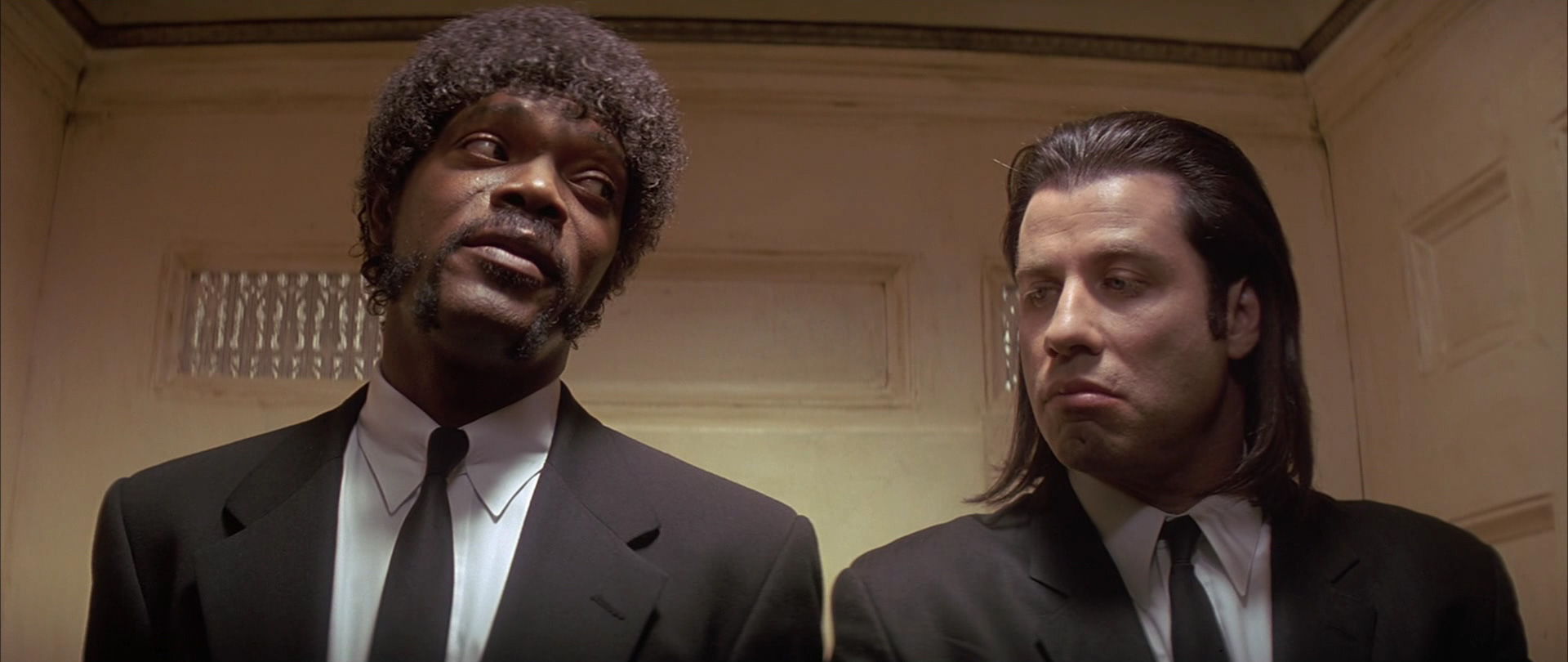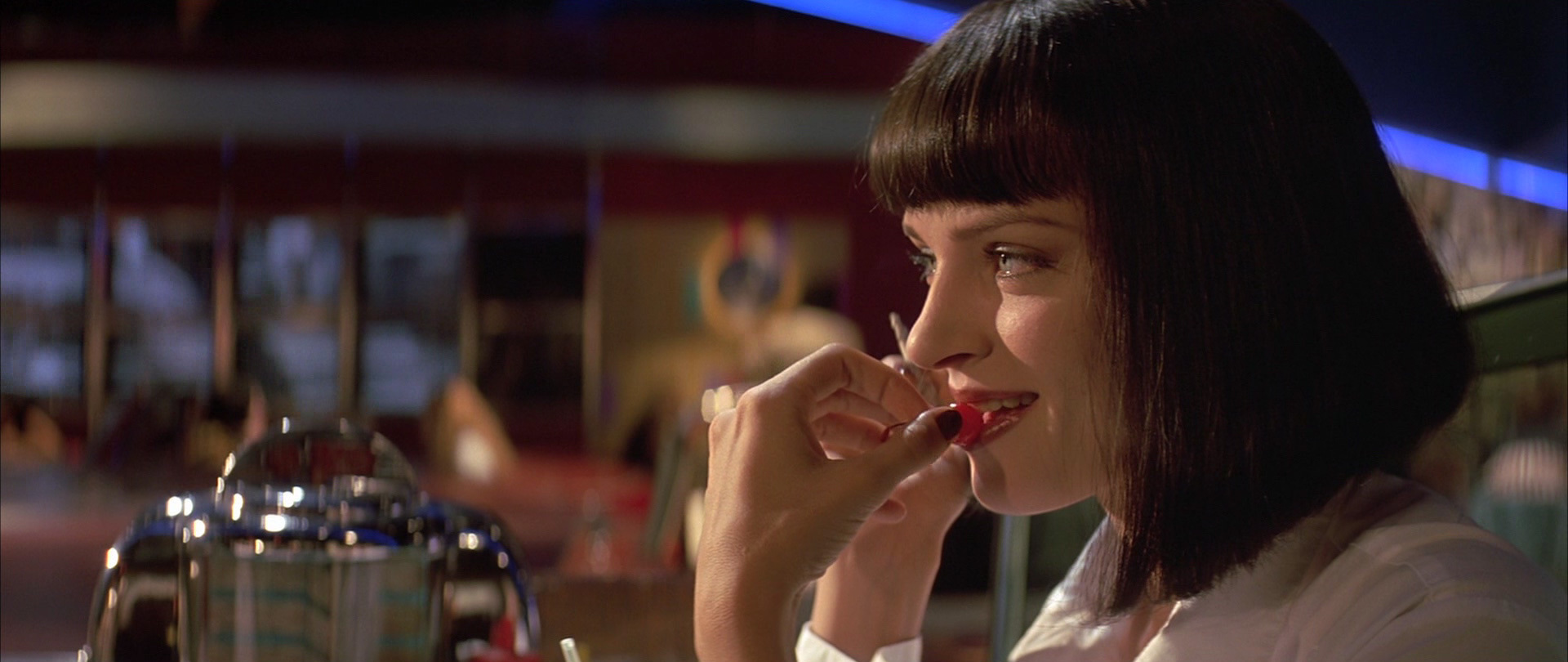Of all the successful components in “Pulp Fiction,” why is dialogue the most important?
Quentin Tarantino is considered one of the geniuses of modern filmmaking not just because of his all-encompassing aptitude for the craft, but because he’s a gifted screenwriter whose dialogue will transcend generations. He writes films with a language that will be studied decades from now, the way modern film scholars look at the innovative use of speech in films like His Girl Friday (1940). Tarantino has a proven ability to create humor without making jokes, and to build tension without requiring a character to raise their voice. Every line of dialogue in his films, perhaps in Pulp Fiction (1994) more than any other, simply carries weight. Nothing is said just to be said, or to fill screen time. Every word has a purpose. Pulp Fiction achieved success with its inventive shuffling of continuity and its memorable performances, but dialogue is what has solidified it as a true modern classic.
Pulp Fiction is one of the most quotable movies ever written. When you reminisce on the film, certain lines and scenes instantly pop into your head: Royale with cheese. Bad motherfucker. Five dollar milkshake. Get the gimp. Zed’s dead. Foot massages. Does Marcellus Wallace look like a bitch? I’m Winston Wolf, I solve problems. And of course, the path of the righteous man is beset on all sides by the inequities of the selfish and the tyranny of evil men.
“Tarantino’s seemingly effortless ability to represent unlikely characters in complex and believable ways through dialogue is comparable to none,” says The Artifice. His “ability to make the viewer smile or even laugh at inappropriate times is one of his defining characteristics as a director and writer. This adds to Pulp Fiction’s authenticity.”
Pulp Fiction’s dialogue isn’t plot-driven. It’s organic and casual, effortlessly working to set the scene and establish the tone of what’s happening (or soon to happen) using philosophical and thought-provoking conversation. In short, it’s interesting. Without being forward with its intent, every word contained in each seemingly innocuous piece of conversation comes back to have greater meaning later. It’s clear that Tarantino wrote Pulp Fiction with botched continuity in mind and carefully plotted the dialogue around that structure. Although the story is out of sequence, the dialogue isn’t. Things mentioned early in the film come full circle later on, even if the later plot point chronologically happened first. We viewers may mentally struggle to piece together the film’s lineage, but the dialogue always knows exactly where to be.
Roger Ebert discusses that concept in his Great Movies article about the film, saying, “It is Tarantino’s strategy in all of his films to have the characters speak at right angles to the action, or depart on flights of fancy. Remember the famous opening conversation between Jules and Vincent, who are on their way to a violent reprisal against some college kids who have offended Wallace and appropriated his famous briefcase. They talk about the drug laws in Amsterdam, what Quarter Pounders are called in Paris, and the degree of sexual intimacy implied by a foot massage. Finally Jules says ‘let’s get in character,’ and they enter an apartment. Tarantino’s dialogue is not simply whimsical. There is a method behind it. The discussion of why Quarter Pounders are called ‘Royales’ in Paris is reprised, a few minutes later, in a tense exchange between Jules and one of the kids (Frank Whaley). And the story of how Marsellus had a man thrown out of a fourth-floor window for giving his wife a foot massage turns out to be a set-up: Tarantino is preparing the dramatic ground for a scene in which Vincent takes Mia Wallace (Uma Thurman) out on a date, on his bosses’ orders.”

Ebert is explaining the tonal relevance of what seems an insipid conversation, as well as its narrative purpose. Tarantino uses a conversation about cheeseburgers and foot massages to build the personalities of the film’s major players while simultaneously establishing future themes and plot points. It seems effortless but is incredibly calculated, and takes talent. Both the cheeseburger and the idea of pushing the boundaries of male-female friendship are seen again in relation to death—one a murder, one a near-overdose—quickly heightening the material that we don’t even expect to be heightened.
Ebert continues, “That scene also begins with dialogue that seems like fun, while it’s also laying more groundwork. We meet Lance’s girlfriend Jody (Rosanna Arquette), who is pierced in every possible place and talks about her piercing fetish. Tarantino is setting up his payoff. When the needle goes into the heart, you’d expect that to be one of the most gruesome moments in the movie, but audiences, curiously, always laugh. QT never actually shows the needle entering the chest. He cuts away to a reaction shot in which everyone hovering over the victim springs back simultaneously as Mia leaps back to life. And then Jody says it was “trippy’’ and we understand that, as a piercer, she has seen the ultimate piercing. The body language and the punchline take a grotesque scene and turn it into dark but genuine comedy. It’s all in the dialogue and the editing.”
Pulp Fiction has an array of high and low moments that cross into territories dumber films wouldn’t dare breach. There’s the long monologue of Christopher Walken’s character talking to the child version of Bruce Willis’ Butch, where the camera hangs on the charismatic Walken’s face for several minutes as he spouts pages of exposition. There’s the long sequence at Jack Rabbit Slim’s which plays like a date in real-time, wherein Mia even addresses the issue of awkward silence as if speaking to the audience. And then that same scene is followed by a humorous dance number that only John Travolta and Uma Thurman, in conjunction with Tarantino’s direction, could pull off. Juxtapose it with the film’s moments of gratuitous violence and intensity, and abrupt scenes where nothingness escalates into extremity with little or no warning, and the film carries itself across a wealth of cinematic inflections.

The Script Lab says, “We’re swept away by Tarantino’s methodical building of tension, shown scenes of abrupt violence impeccably accented by the application of Tarantino’s jazzy breed of iambic pentameter. The dialogue is as humorous as the violence is venomous, making ‘pulp’ the last thing on our minds.”
Wherever it roams, Pulp Fiction’s original characters and extravagant but fully-embraced situations are given the right dialogue to support them.
Tarantino’s films are long, but not because they’re filled with needless action sequences or grotesque displays of special effects—that’s the reason Transformers: Revenge of the Fallen (2009) clocks in at an abhorrent 2.5 hours. Tarantino’s films are long with interesting, rich language that is telling a story and building characters as prolifically as the best novels. Even if Tarantino had no aptitude behind the camera or for extracting talent from performers (both of which he has in spades), he would still exist as a man in the foreground of cinema for his screenplays. And that truth is a testament to the meaty dialogue at the core of his remarkable library of films, a library in which Pulp Fiction will likely be immortalized as one of his greatest entries.

